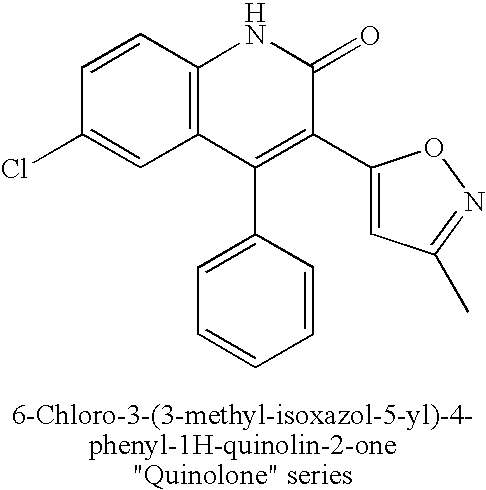Crystal structure of the c-fms kinase domain: applications and use of heterologous substitutions of kinase insert domains for crystallization
a technology of cfms kinase and insert domain, which is applied in the field of crystal structure of cfms kinase domain, can solve problems such as improper positioning of loops, and achieve the effect of improving complex formation and improving binding inhibition
- Summary
- Abstract
- Description
- Claims
- Application Information
AI Technical Summary
Benefits of technology
Problems solved by technology
Method used
Image
Examples
specific embodiments
Detailed Embodiments
[0117] Included in this invention is a substitution of the native kinase insert domain of c-fms, which due to its structural bulk and potential disorder, prevents crystallization of the native protein. The invention also includes a method for replacing the native kinase insert domain with shorter kinase insert domains from the FGF receptor kinase, the tie-2 kinase and the insulin receptor kinase, and obtaining crystals of a c-fms-chimeric protein.
A. Modeling the Three-Dimensional Structure of the c-fms Chimeric Protein
[0118] The atomic coordinate data provided in Tables 1, 2 or 3 or the coordinate data derived from homologous proteins may be used to build a three-dimensional model of a c-fms chimeric protein. Any available computational methods may be used to build the three dimensional model. As a starting point, the X-ray diffraction pattern obtained from the assemblage of the molecules or atoms in a crystalline version of a c-fms chimera or a c-fms chimeri...
example 1
Cloning of c-FMS-FGFR1 Chimera 538-922
[0206] All constructs begin at amino acid 538 of FMS and end at amino acid 922 of FMS. Chimeras were created by replacing FMS KID with KID sequences from RTK's known to be structured, like tie2 and irk. Chimeras are based on structure prediction and sequence alignment.
[0207] c-fms fragments from amino acids 922-678 and 753-922 were generated by PCR using a c-fms construct derived by RT-PCR from THP-1 cells. For cloning purposes, a Sal I site was included on the 5′ side of the 922-678 PCR product and a stop codon followed by a Not I site was included on the 3′ end of the 753-922 PCR product. The FGFR1 kinase insert domain was generated by annealing 2 synthesized oligonucleotides corresponding to amino acids 671-679 of c-fms, followed by amino acids 577-617 of FGFR1 and ending with amino acids 753-760 of c-fms. To obtain the chimera, overlapping PCR was performed using the FMS PCR fragments 922-678 and 753-922 and the annealed synthesized FGFR1 ...
example 2
Protein Purification
[0208] Frozen cells were thawed and resuspended in 50 mM NaKPO4 pH 7.5, 200 mM NaCl, 5% Glycerol, 1 mM Glutathione, 5 mM Imidazole, 1× Complete EDTA-free protease inhibitor cocktail (Roche) (Buffer A). Thawed cells were dounce homogenized, mechanically lysed with an Emulsiflex-C5 (Avestin) at 10,000-15,000 psi and centrifuged at 40,000×g (16,000 rpm) for 1 hour to remove insoluble material. The supernatant was filtered through a 0.45 μm vacuum filter and incubated with a BD Talon metal affinity resin (BD Biosciences Clontech) overnight at 4° C. After 20 column volumes washes with buffer A containing 10 mM Imidazole, c-fms was eluted using a 10 column volume linear gradient from 10 mM to 200 mM Imidazole in buffer A. Fractions containing c-fms, as assayed by SDS-PAGE, were pooled and combined with 0.2 Units of TEV Protease (Invitrogen) / μg of c-fms to remove the histidine tag. The reaction was dialyzed overnight against 50 mM NaKPO4 pH 7.5, 200 mM NaCl, 5% Glycero...
PUM
| Property | Measurement | Unit |
|---|---|---|
| Fraction | aaaaa | aaaaa |
| Length | aaaaa | aaaaa |
| Chemical shift | aaaaa | aaaaa |
Abstract
Description
Claims
Application Information
 Login to View More
Login to View More - R&D
- Intellectual Property
- Life Sciences
- Materials
- Tech Scout
- Unparalleled Data Quality
- Higher Quality Content
- 60% Fewer Hallucinations
Browse by: Latest US Patents, China's latest patents, Technical Efficacy Thesaurus, Application Domain, Technology Topic, Popular Technical Reports.
© 2025 PatSnap. All rights reserved.Legal|Privacy policy|Modern Slavery Act Transparency Statement|Sitemap|About US| Contact US: help@patsnap.com



